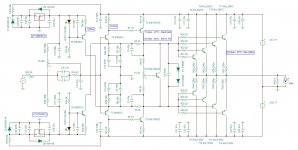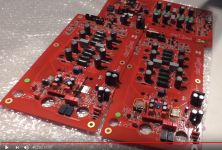The 108 is an ancient Revox with a standard diamond buffer output. Its inherent lack of sophistication is the principal reason all the amplifier wizards of this forum avoid this thread like the plague. Too primitive technically. Dismal specs.
The 458 is even simpler, with an even more mundane emitter follower output. The topology cannot even qualify as textbook. Even PA amps are more sophisticated. Zero chance to attract a wizard 🙂
It takes a brave man with excellent hearing acuity and little self doubt to build a superamp on such flimsy foundations. The commercial success flies in the face of engineering wisdom and shows the gaping void between technical excellence and musically convincing reproduction.
The 458 is even simpler, with an even more mundane emitter follower output. The topology cannot even qualify as textbook. Even PA amps are more sophisticated. Zero chance to attract a wizard 🙂
It takes a brave man with excellent hearing acuity and little self doubt to build a superamp on such flimsy foundations. The commercial success flies in the face of engineering wisdom and shows the gaping void between technical excellence and musically convincing reproduction.
If I can .
the 108, which I made from the Chinese card, and also modified, is a scheme that can give satisfactions; we consider that it was developed by the manufacturer with a single-track, at least so it is said; therefore it is understandable to have a setting as the manufacturer likes with some qualities, some defects, many, but what has no defects.
The open loop scheme, if well done, is interesting, but the scheme itself may have inherent limitations.
The scheme of 458, at least what I have, seems very interesting and seems designed to remedy some of the many problems of 108.
Not having the Chinese card, I designed the 458 card / PCB, but with a different focus on the masses than the 108 Chinese card design.
The turn of the signal masses in the PCBs is important.
This is what I think of 108 and, I assume, of 458
the 108, which I made from the Chinese card, and also modified, is a scheme that can give satisfactions; we consider that it was developed by the manufacturer with a single-track, at least so it is said; therefore it is understandable to have a setting as the manufacturer likes with some qualities, some defects, many, but what has no defects.
The open loop scheme, if well done, is interesting, but the scheme itself may have inherent limitations.
The scheme of 458, at least what I have, seems very interesting and seems designed to remedy some of the many problems of 108.
Not having the Chinese card, I designed the 458 card / PCB, but with a different focus on the masses than the 108 Chinese card design.
The turn of the signal masses in the PCBs is important.
This is what I think of 108 and, I assume, of 458
Did you like the KSA 50?
Well
The 108 is the exact opposite as sound
Do you absolutely want to do 108?
Okay
But the 108 imposes a very particular, very limited sound.
Is it worth starting a job to have a very personalized sound to the taste of others?
Here you have to answer, only you.
Otherwise there are also very, but very performing alternatives ..................... Spectral tout dc e tout stabilized
Last edited:
But the 108 imposes a very particular, very limited sound.
Yes, it is hardly an appropriate amp for rockers.
with a different focus on the masses than the 108 Chinese card design.
The single pair clones simply replicate the pcb layout of the original and the grounding scheme is exactly the same. You can improve it but it won't be a clone anymore.
The single pair clones simply replicate the pcb layout of the original and the grounding scheme is exactly the same. You can improve it but it won't be a clone anymore.
well, if one remakes the PCB, he thinks of remaking it to improve it.
PS
I think too and I'm almost sure that the 2 PCBs, Chinese and Switzerland, are exactly identical.
And that's why I feel like saying something about both, without offending anyone!
I always say, too, that all those filtering capacitors, 6 of 22,000 micro per channel, are smoke, nothing else.
And even those transformers so big: why on earth?
ah, € 38,000, I pay them less ................... 🙄
And even those transformers so big: why on earth?
Because we all have a different taste: i like big transformers and a lot of capacitance and dislike active regulation, especially series regulators.
Of course it is hard to have rules about these things. Some circuits have sufficient psrr and regulation does not contribute anything worthwhile to the sound while other circuits really seem to need it. LC regulation fits somewhere in-between but is heavy and expensive.
Sonic-wise it is always a compromise between different qualities; there is no golden recipe.
Because we all have a different taste: i like big transformers and a lot of capacitance and dislike active regulation, especially series regulators.
Of course it is hard to have rules about these things. Some circuits have sufficient psrr and regulation does not contribute anything worthwhile to the sound while other circuits really seem to need it. LC regulation fits somewhere in-between but is heavy and expensive.
Sonic-wise it is always a compromise between different qualities; there is no golden recipe.
I was referring to such large transformers and those capacities for a scheme that does not benefit (PROVEN).
Then stabilizing everything, so far, has always been very okay.
I am still not convinced that Shany’s version is "copied down" from a real 458 unit 😀There are many, lately with a cascode. The version that appears to follow the 458 is in post #584
If you are referring to the Shany's schematic, I do not see how 458 has more nfb and/or more olg compared to 108. I cannot see how it can properly drive four pairs of output transistors and difficult load with its flimsy frontend.The 458 has more power, better ability to drive difficult loads, less distortion due to more nfb. If you have easy speakers some of these might not be important. It is a very different amplifier and a much more demanding build.
But it is just me wondering, based on a LTSpice simulation. I have never tried the alleged 485 schematic in the real world 😎
Last edited:
And i was referring to this being a question of taste 🙂
mmmmmhh , 😀
This circuit is designed to produce mid level distortion. You should look at it from another aspect. E.g. it is a tube amplifier which has high output power and speaker driving capability.... I cannot see how it can properly drive four pairs of output transistors and difficult load with its flimsy frontend.
But it is just me wondering, based on a LTSpice simulation. I have never tried the alleged 485 schematic in the real world 😎
In my opinion the darTZeel sound phenomenon is caused by two elements. The summing-up of the sharp-edged distortion of circuit and the "soft sound" of particular components can create a preferable balance with smooth and detailed, living sound at the same time...not for everyone, of course.
So it is only an unusual schematic, everyone is able to design a better one. And everyone can select "better" audiophile parts than the original components. But an improved version will not result in the original darTZeel sound...
I spent more time with the seeking of type of components than the electrical analysis of circuit. I have only started the building of my amp when I have already had acceptable information concerning the original parts.
Attachments
Thanks shany! 😎 That's really cool.
In my opinion this is the key development of this thread: now, we have the scheme.
On audiodiyers.hu, there is a great deal of information on this subject. The site is in Hungarian language, but you may turn-on translation to English.
In my humble opinion, the present scheme is based on a serious, in-depth analysis. This is a great opportunity for the »wizards« among us.😉
This situation resembles a simmilar event on another thread where a member "bra" from Poland came along with a scheme and that was the starting point of probably the most fruitful thread here: "Krell KSA 50 pcb"
Can we build this? 😕
In my opinion this is the key development of this thread: now, we have the scheme.
On audiodiyers.hu, there is a great deal of information on this subject. The site is in Hungarian language, but you may turn-on translation to English.
In my humble opinion, the present scheme is based on a serious, in-depth analysis. This is a great opportunity for the »wizards« among us.😉
This situation resembles a simmilar event on another thread where a member "bra" from Poland came along with a scheme and that was the starting point of probably the most fruitful thread here: "Krell KSA 50 pcb"
Can we build this? 😕
"....I have only started the building of my amp when I have already had acceptable information concerning the original parts.
Hello,
I have followed you on the Hungarian forum, thanks to Google translate. I am very impressed by your knowledge and I cannot wait for more information on the project.
I just have one question regarding the circuit diagram:
In the YouTube factory tour by M. Fremmer at YouTube Mr D. shows off old 458 MBs at around 39.09 and onwards. There you can see two metal components sticking out from underneath the daughter card at the bottom of the MB (circled in yellow).
What could those be?
Attachments
Last edited:
I am still not convinced that Shany’s version is "copied down" from a real 458 unit 😀
Ehm, someone known for dramatic statements followed by protracted absences confirmed this earlier on in this thread. He had a look inside his buddies 458 and everything was exactly the same. Allegedly 🙂 But i choose to believe it.
If you are referring to the Shany's schematic, I do not see how 458 has more nfb and/or more olg compared to 108. I cannot see how it can properly drive four pairs of output transistors and difficult load with its flimsy frontend.
And you are quite right, my bad with the sims, did not load them equally. Now the 108 has an olg of 85000 and the 458 only 20000. Do you get figures in the same range?
As for maximum power I get 2.28% thd at 1kW/2ohm whereas the Stereophile test measured 1%.
Overall, not too shabby for Shany's circuit 🙂
Last edited:
supercap?
Certainly. I cannot quite understand why supercaps are preferable to large, good sounding electrolytics but they are certainly a lot cheaper.
Very tempted to replace the input stage CCS with a single IXTU01N100D. Why? Because it is the best sounding simple CCS solution i know of and because it is even objectively better than the bipolar CCS in the 458. Besides, together with a pot it can be used to adjust the offset. Yes, it will no longer be a "genuine" copy 😀
Thoughts?
Thoughts?
Certainly. I cannot quite understand why supercaps are preferable to large, good sounding electrolytics but they are certainly a lot cheaper.
I thought the Supercaps are some "Magic Wands" that automatically control the DC offset in D's circuits?
They have three "legs" right? Can they be replaced with a regular (audio) Capacitor?
- Home
- Amplifiers
- Solid State
- Dartzeel amp schematic - build this?

